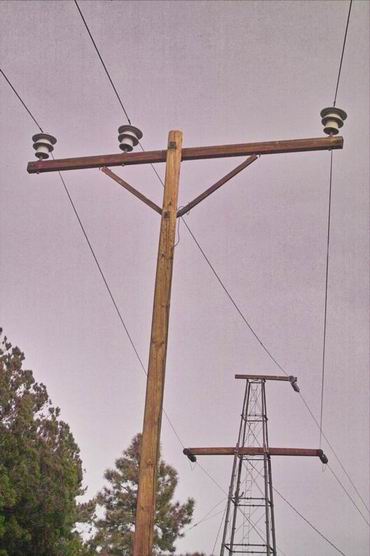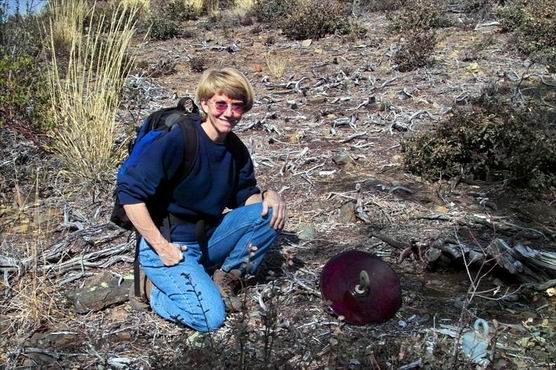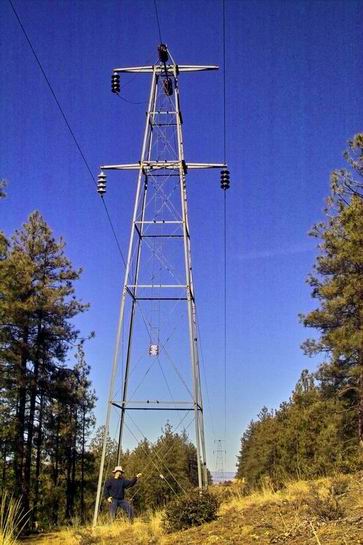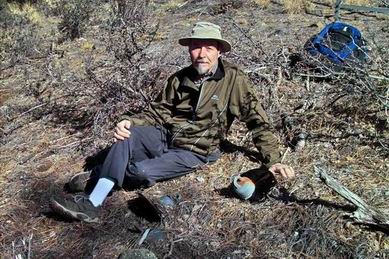12th Christmans (cont'd,
Page 2)
R=∞
Home
12th Christmas: Page
1 Page 3
 There
is a section of the line that runs northeast over the shoulder of Mingus
Mountain and then down to Jerome. Towers
are still in service, visible from the modern highway 85A.
We find a trailhead, and start hiking, encountering the line within half
a mile. These are the steel towers
to be sure, but they have wood crossarms. Of all the
crazy things. Lots of small pieces
of flat Thomas suspension plates, but these are the 12 in. ones, not 15 in. like
the article said. We had been
suspicious of the 15 in. from the beginning, because the only Thomas suspension
plates that large were the 2-part units used by Southern Power. In any case, we are on the right line, and finding stuff.
After a couple of hours we are scrambling down a steep hillside to the
last tower before a long span across a deep gorge.
We discover why the cholla is called “jumping cactus”---it almost leaps out at you,
and its barbed spines aren’t impeded in the slightest by leather gloves!
After pulling spines from fingers (ouch!), we explore the tower site and find
some broken flat Thomas suspensions, and two hook-and-eye units with the
porcelain broken off. Barb is rummaging around in a pile of leaves under a bush.
After a few minutes she appears with a whole flat Thomas suspension plate,
unharmed except for three radial stress cracks. Wow, a whole one!
There
is a section of the line that runs northeast over the shoulder of Mingus
Mountain and then down to Jerome. Towers
are still in service, visible from the modern highway 85A.
We find a trailhead, and start hiking, encountering the line within half
a mile. These are the steel towers
to be sure, but they have wood crossarms. Of all the
crazy things. Lots of small pieces
of flat Thomas suspension plates, but these are the 12 in. ones, not 15 in. like
the article said. We had been
suspicious of the 15 in. from the beginning, because the only Thomas suspension
plates that large were the 2-part units used by Southern Power. In any case, we are on the right line, and finding stuff.
After a couple of hours we are scrambling down a steep hillside to the
last tower before a long span across a deep gorge.
We discover why the cholla is called “jumping cactus”---it almost leaps out at you,
and its barbed spines aren’t impeded in the slightest by leather gloves!
After pulling spines from fingers (ouch!), we explore the tower site and find
some broken flat Thomas suspensions, and two hook-and-eye units with the
porcelain broken off. Barb is rummaging around in a pile of leaves under a bush.
After a few minutes she appears with a whole flat Thomas suspension plate,
unharmed except for three radial stress cracks. Wow, a whole one!

Line maps from 1916 show a second line running
north-northwest from the plant up along the Verde River and directly into
Jerome. Part of this line runs over
the shoulder of Squaw Peak, quite far from any access. Because this section is of later origin, it is unlikely to
have the original insulators, but we have been surprised before.
Let’s check it out. We
drive south from Camp Verde to Rodeo Flats, and start hiking.
The line there looks like just another wood-pole line, equipped with
modern 4-string suspension insulators. Several
pole sites have abandoned crossarms scattered about. Then Barb unearths the core of a modest-sized three-part
pin-type insulator. It must be
original, judging from its crown and wire groove.
Couldn’t be more than 30kV. Hmmm.
We trudge on. Up on one
lonely, windswept ridge stands a tall, handsome, modern pole.
Fifty feet away there is a group of three pole stubs of decreasing size
and increasing age. Under a bush
not far away are two hook-and-eye units with porcelain broken off.
So they did use them here! Carver
is studiously contemplating the scene when he hears a faint voice “come over
here”. There in the middle of an
open, grassy area is a mint flat Thomas suspension!
In the most unlikely place!
 The
Bradshaw Mountains are high and rugged. There
are numerous old mining roads, and a lot of public land laced with thickets of
private mining claims. It is often
hard to know where we are relative to private land boundaries.
At first, we drive public roads to get a feel for the area.
The line is shown clearly on modern topographic maps, but when we drive
to the place where it crosses the road, it
just isn’t there! Well, this
is not an auspicious way to begin. Back
to the maps. More driving. Some wood poles. More
maps. More driving.
Finally we head for the most remote section we can find on the map.
One hiking trail is shown crossing it.
As we break out of the pine forest there
is a tower! Still in service! And it has the original metal crossarms!
And the line keeps going for miles!
Now we can hunt!
The
Bradshaw Mountains are high and rugged. There
are numerous old mining roads, and a lot of public land laced with thickets of
private mining claims. It is often
hard to know where we are relative to private land boundaries.
At first, we drive public roads to get a feel for the area.
The line is shown clearly on modern topographic maps, but when we drive
to the place where it crosses the road, it
just isn’t there! Well, this
is not an auspicious way to begin. Back
to the maps. More driving. Some wood poles. More
maps. More driving.
Finally we head for the most remote section we can find on the map.
One hiking trail is shown crossing it.
As we break out of the pine forest there
is a tower! Still in service! And it has the original metal crossarms!
And the line keeps going for miles!
Now we can hunt!
Numerous broken Thomas pieces litter the area,
along with a few hook-and-eye units. The
line is headed downhill, along the side of the mountain.
Each tower is located on a ridge. Towers
are separated by gulches of various depths.
We are so excited that the terrain doesn’t seem that bad.
After a few dozen towers we are getting really far from the trailhead.
We now have a lot of Thomas plates with half to two-thirds of their
porcelain, and the possibility of finding the missing pieces.
Perhaps this whole hunt will turn into a giant glue job!
Then we reach a corner tower, where the line makes a turn. These are always good because they used two to three times
the number of insulators.
Carver shouts “hey, there’s one.”
Sure enough, on the lower edge of the right-of-way are two big, flat
Thomas plates! We pull them out,
dust them off, and one of them is mint! Barb
starts exploring a big pile of dead limbs left by the brush crew on the upper
side of the right-of-way. Sure
enough, more plates under there. After
pulling off limbs and digging out plates, we have three more good ones, along
with a dozen broken ones. Back to
the cut brush on the downhill side. More
under there. More moving brush,
more digging, more broken plates, but two more good ones.

12th Christmas: Page 1
Page 3
R=∞
Home
 There
is a section of the line that runs northeast over the shoulder of Mingus
Mountain and then down to Jerome. Towers
are still in service, visible from the modern highway 85A.
We find a trailhead, and start hiking, encountering the line within half
a mile. These are the steel towers
to be sure, but they have wood crossarms. Of all the
crazy things. Lots of small pieces
of flat Thomas suspension plates, but these are the 12 in. ones, not 15 in. like
the article said. We had been
suspicious of the 15 in. from the beginning, because the only Thomas suspension
plates that large were the 2-part units used by Southern Power. In any case, we are on the right line, and finding stuff.
After a couple of hours we are scrambling down a steep hillside to the
last tower before a long span across a deep gorge.
We discover why the cholla is called “jumping cactus”---it almost leaps out at you,
and its barbed spines aren’t impeded in the slightest by leather gloves!
After pulling spines from fingers (ouch!), we explore the tower site and find
some broken flat Thomas suspensions, and two hook-and-eye units with the
porcelain broken off. Barb is rummaging around in a pile of leaves under a bush.
After a few minutes she appears with a whole flat Thomas suspension plate,
unharmed except for three radial stress cracks. Wow, a whole one!
There
is a section of the line that runs northeast over the shoulder of Mingus
Mountain and then down to Jerome. Towers
are still in service, visible from the modern highway 85A.
We find a trailhead, and start hiking, encountering the line within half
a mile. These are the steel towers
to be sure, but they have wood crossarms. Of all the
crazy things. Lots of small pieces
of flat Thomas suspension plates, but these are the 12 in. ones, not 15 in. like
the article said. We had been
suspicious of the 15 in. from the beginning, because the only Thomas suspension
plates that large were the 2-part units used by Southern Power. In any case, we are on the right line, and finding stuff.
After a couple of hours we are scrambling down a steep hillside to the
last tower before a long span across a deep gorge.
We discover why the cholla is called “jumping cactus”---it almost leaps out at you,
and its barbed spines aren’t impeded in the slightest by leather gloves!
After pulling spines from fingers (ouch!), we explore the tower site and find
some broken flat Thomas suspensions, and two hook-and-eye units with the
porcelain broken off. Barb is rummaging around in a pile of leaves under a bush.
After a few minutes she appears with a whole flat Thomas suspension plate,
unharmed except for three radial stress cracks. Wow, a whole one!
 The
Bradshaw Mountains are high and rugged.
The
Bradshaw Mountains are high and rugged.